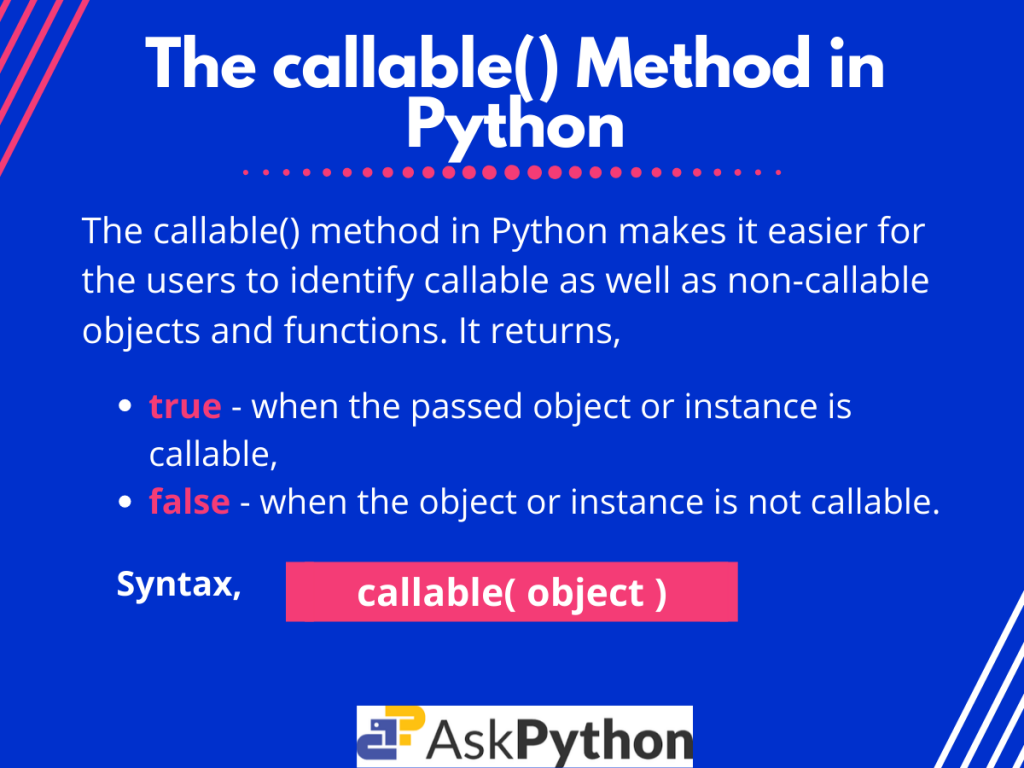- Тип аннотации Callable() модуля typing в Python.
- Типизация функций обратного вызова.
- Синтаксис:
- Параметры:
- Описание:
- Как использовать метод Python Callable ()
- Вступление
- Метод Python Callable ()
- Работа метода Python Callable ()
- Когда Python Callable () возвращает true
- Когда Python Callable () возвращает false
- Заключение
- How to Use the Python callable() Method
- Introduction
- The Python callable() Method
- Working of the Python callable() Method
- When Python callable() returns True
- When Python callable() returns False
- Conclusion
- What is a «callable»?
- 12 Answers 12
- Example
- Python callable
- Introduction to Python callables
- Python callable function examples
- 1) built-in functions
- 2) User-defined functions
- 3) built-in methods
- 4) Classes
- 5) Methods
- 6) Instances of a class
Тип аннотации Callable() модуля typing в Python.
Типизация функций обратного вызова.
Может использоваться как тип в аннотациях с помощью синтаксиса [] .
Синтаксис:
Параметры:
- x — список аргументов функции,
- Y — тип возвращаемого значения.
Описание:
Тип аннотации Callable модуля typing применяется для типизации функций обратного вызова, для объектов, которые их ожидают.
Запись Callable[[int], str] является функцией от (int) -> str . Синтаксис аннотации всегда должен использоваться ровно с двумя значениями: список аргументов и тип возвращаемого значения. Список аргументов должен быть списком типов или многоточием, возвращаемый тип должен быть одного типа.
Не существует синтаксиса для указания необязательных аргументов или ключевых аргументов. Такие типы функций редко используются как типы обратного вызова.
Форма записи как Callable[. ReturnType] (буквальное многоточие) может использоваться в качестве подсказки для вызываемого объекта, принимающего любое количество аргументов и возвращающего ReturnType . Обычный Callable эквивалентен Callable[. Any] , а такая запись, свою очередь, эквивалентна встроенному абстрактному классу collections.abc.Callable .
Вызываемые объекты, которые принимают другие вызываемые объекты в качестве аргументов, могут указывать на то, что их типы параметров зависят друг от друга с помощью typing.ParamSpec . Кроме того, если этот вызываемый объект добавляет или удаляет аргументы из других вызываемых объектов, может использоваться оператор typing.Concatenate . Они принимают форму Callable[ParamSpecVariable, ReturnType] и Callable[Concatenate [Arg1Type, Arg2Type, . ParamSpecVariable], ReturnType] соответственно.
Не рекомендуется к применению с Python 3.9: встроенный абстрактный базовый класс collections.abc.Callable теперь поддерживает синтаксис [] .
Так же смотрите встроенный в Python «Тип псевдоним».
Источник
Как использовать метод Python Callable ()
В этом руководстве мы собираемся обсудить метод Python Callable () вместе с его использованием и работающим.
Автор: Pankaj Kumar
Дата записи
Вступление
В этом руководстве мы собираемся обсудить Python Callable () Метод наряду с его использованием и работающим.
В основном, объект или экземпляр называется Callable Когда он имеет определенный __call __ () функция. В этом случае мы можем ссылаться на .__ Call __ (ARG1, ARG2, …) в проще, A (ARG1, ARG2, …). Следовательно, это становится Callable.
Метод Python Callable ()
Далее Callable () Метод в Python облегчает для пользователей выявлять Callable, а также не вызываемые объекты и функции. Это единственная функция аргумента, которая возвращает правда Если пропущенный объект Callable и ложь Если это не так.
синтаксис Для метода приведен ниже,
Здесь obj является ли экземпляром или объектом, который пользователь хочет проверить, вызывается или нет.
Работа метода Python Callable ()
Давайте посмотрим на некоторые примеры, чтобы иметь четкое понимание Callable () Метод в Python.
Когда Python Callable () возвращает true
Как заявлено ранее, метод возвращает правда Когда прошедший объект Callable. Давайте посмотрим на какие условия это так.
Выход :
- Мы определяем Демо () Функция, создать свой новый экземпляр Demo_obj ,
- Затем определите новый класс Demo_Class с __call __ () функция,
- И создать объект класса Demo_Class по имени demo_class_obj ,
- Наконец, проверьте, являются ли созданные объекты и класс Callable или нет. Что мы можем видеть с вывода, Callable.
- И наконец, мы называем как функцию Демо () и demo_class_obj () Отказ В случае объекта Demo Class Call, __call __ () Способ выполнен, как мы можем видеть с вывода.
Примечание: Все классы Callable, поэтому для любого класса Callable () метод возвращает true. Это очевидно из приведенного выше примера, где мы пытаемся проверить Callable () Выход для DEMO_CLASS.
Когда Python Callable () возвращает false
Опять же, Callable () Возвращает ложь Когда проходящий объект не вызывается. Давайте посмотрим на то, что это делает это.
Выход :
- Мы инициализируем целое число n как N ,
- А затем определить класс Demo_Class с функцией участника print_demo () ,
- После этого мы создаем объект demo_class по имени demo_class_obj ,
- И, наконец, проверьте ли N и demo_class_obj Callable или нет, что из выхода выше, мы видим, что не вызываются.
N это целое число и явно не может быть вызвано. Принимая во внимание, что в случае demo_class_obj класс (demo_class) не имеет четко определенного __call __ () метод. Следовательно, не вызывается.
Заключение
Итак, в этом руководстве мы узнали о Python Callable () Метод и его работа. Метод широко используется для ошибок проверки программы.
Проверка, если объект или функция вызывается или не до того, как на самом деле вызывает, это помогает избежать Типеррор Отказ
Я надеюсь, что у вас есть четкое понимание темы. Для любых вопросов не стесняйтесь комментировать ниже.
Источник
How to Use the Python callable() Method
Introduction
In this tutorial, we are going to discuss the Python callable() method along with its uses and working.
Basically, an object or instance is termed callable when it has a defined __call__() function. In that case, we can refer to a.__call__(arg1, arg2, …) in a simpler way, a(arg1,arg2, …). Hence, it becomes callable.
The Python callable() Method
Further, the callable() method in Python makes it easier for the users to identify callable as well as non-callable objects and functions. It is a single argument function, that returns true if the passed object is callable and false if it is not.
The syntax for the method is given below,
Here, the obj is the instance or object that the user wants to check is callable or not.
Working of the Python callable() Method
Let us look at some examples to have a clear understanding of the callable() method in Python.
When Python callable() returns True
As stated earlier, the method returns true when the passed object is callable. Let us see for what conditions it does so.
Output:
- We define demo() function, create its new instance demo_obj,
- Then define a new class demo_class with __call__() function,
- And create an object of the class demo_class named demo_class_obj,
- Finally, check whether the created objects and the class are callable or not. Which we can see from the output, are callable.
- And at last, we call both the function demo() and the demo_class_obj() . In the case of the demo class’s object call, the __call__() method is executed as we can see from the output.
Note: All classes are callable, so for any class, callable() method returns true. This is evident from the above example, where we try checking the callable() output for demo_class.
When Python callable() returns False
Again, callable() returns false when the passed object is not callable. Let us see for what conditions it does that.
Output:
In the code above,
- We initialize an integer n as n = 10,
- And then define a class demo_class with member function print_demo() ,
- After that, we create an object of the demo_class named demo_class_obj,
- And finally, check whether n and demo_class_obj are callable or not, Which from the output above, we can see that are not callable.
n is an integer and clearly cannot be called. Whereas in the case of the demo_class_obj, the class(demo_class) doesn’t have a well defined
__call__() method. Hence is not callable.
Conclusion
So, in this tutorial, we learned about the Python callable() method, and its working. The method is widely used for error proofing a program.
Checking if an object or function is callable or not before actually calling it helps avoid TypeError.
I hope you have a clear understanding of the topic. For any questions feel free to comment below.
Источник
What is a «callable»?
Now that it’s clear what a metaclass is, there is an associated concept that I use all the time without knowing what it really means.
I suppose everybody made once a mistake with parenthesis, resulting in an «object is not callable» exception. What’s more, using __init__ and __new__ lead to wonder what this bloody __call__ can be used for.
Could you give me some explanations, including examples with the magic method ?
12 Answers 12
A callable is anything that can be called.
- an instance of a class with a __call__ method or
- is of a type that has a non null tp_call (c struct) member which indicates callability otherwise (such as in functions, methods etc.)
Called when the instance is »called» as a function
Example
From Python’s sources object.c:
- If an object is an instance of some class then it is callable iff it has __call__ attribute.
- Else the object x is callable iff x->ob_type->tp_call != NULL
ternaryfunc tp_call An optional pointer to a function that implements calling the object. This should be NULL if the object is not callable. The signature is the same as for PyObject_Call(). This field is inherited by subtypes.
You can always use built-in callable function to determine whether given object is callable or not; or better yet just call it and catch TypeError later. callable is removed in Python 3.0 and 3.1, use callable = lambda o: hasattr(o, ‘__call__’) or isinstance(o, collections.Callable) .
Example, a simplistic cache implementation:
Источник
Python callable
Summary: in this tutorial, you’ll learn about Python callable objects and how to use the callable function to check if an object is callable.
Introduction to Python callables
When you can call an object using the () operator, that object is callable:
For example, functions and methods are callable. In Python, many other objects are also callable.
A callable always returns a value.
To check if an object is callable, you can use the built-in function callable :
The callable function accepts an object. It returns True if the object is callable. Otherwise, it returns False .
Python callable function examples
The following illustrates the various types of callable objects in Python.
1) built-in functions
All built-in functions are callable. For example, print , len , even callable .
2) User-defined functions
All user-defined functions created using def or lambda expressions are callable. For example:
3) built-in methods
The built-in method such as a_str.upper , a_list.append are callable. For example:
4) Classes
All classes are callable. When you call a class, you get a new instance of the class. For example:
5) Methods
Methods are functions bound to an object, therefore, they’re also callable. For example:
6) Instances of a class
If a class implements the __call__ method, all instances of the class are callable:
Источник





